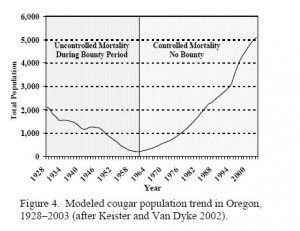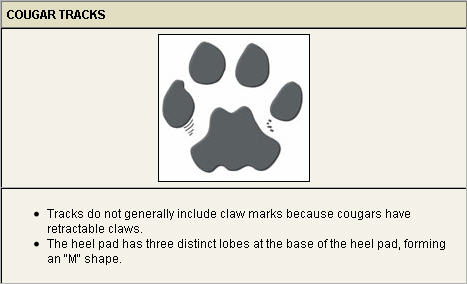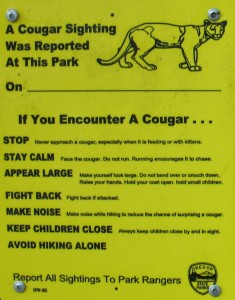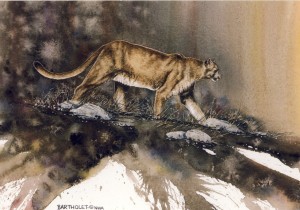 Although archeological records are obscure, the cougar likely evolved as a distinct species 390,000 years ago. Scientists suggest cougars likely went extinct in North America during the late Pleistocene Era 10,000–12,000 years ago. Extant populations in North America are likely the result of natural re-colonization from surviving animals in Central and South America. Historically cougar populations were at much lower numbers than are currently estimated in Oregon. The current cougar population in Oregon is estimated to be more than 5,700.
Although archeological records are obscure, the cougar likely evolved as a distinct species 390,000 years ago. Scientists suggest cougars likely went extinct in North America during the late Pleistocene Era 10,000–12,000 years ago. Extant populations in North America are likely the result of natural re-colonization from surviving animals in Central and South America. Historically cougar populations were at much lower numbers than are currently estimated in Oregon. The current cougar population in Oregon is estimated to be more than 5,700.
 Since the opening of the Oregon territory cougars were considered the arch-villains of the forests and were hunted ferociously. In Oregon’s early history, cougars were characterized as abundant or common throughout most of the forested parts of the state. Settlement, and burgeoning timber and agricultural industries created conflicts between human interests and cougars. First bounty offered by territorial government in 1843. Bounty in 1911 was $10. Bounties and unregulated take caused cougar numbers to decline markedly from historic levels by the 1930s, and continued to decrease through the late 1960s. 1962-1967: Hunting became more popular as road construction increased and more efficient snow travel equipment was developed. The 1967 Oregon Legislature granted the Oregon State Game Commission authority to declare cougar a game animal. Bounties were no longer in effect. 1994: Measure 18, a citizen Ballot Initiative, was passed making it unlawful for hunters to pursue cougars with dogs. In 2001 the legislature passed a law making it legal for persons to take a cougar posing a threat to human safety without a permit.
Since the opening of the Oregon territory cougars were considered the arch-villains of the forests and were hunted ferociously. In Oregon’s early history, cougars were characterized as abundant or common throughout most of the forested parts of the state. Settlement, and burgeoning timber and agricultural industries created conflicts between human interests and cougars. First bounty offered by territorial government in 1843. Bounty in 1911 was $10. Bounties and unregulated take caused cougar numbers to decline markedly from historic levels by the 1930s, and continued to decrease through the late 1960s. 1962-1967: Hunting became more popular as road construction increased and more efficient snow travel equipment was developed. The 1967 Oregon Legislature granted the Oregon State Game Commission authority to declare cougar a game animal. Bounties were no longer in effect. 1994: Measure 18, a citizen Ballot Initiative, was passed making it unlawful for hunters to pursue cougars with dogs. In 2001 the legislature passed a law making it legal for persons to take a cougar posing a threat to human safety without a permit.
 Female cougars may have one to six kittens per litter, but average two to three kittens per
Female cougars may have one to six kittens per litter, but average two to three kittens per
litter. Cougars have a relatively high reproductive potential, and they can quickly replace individuals lost from the population.
Cougars generally move at night with most movements beginning near dusk. Within a population, males make greater daily movements. The longer daily movements of males compared to females result from nightly patrols to defend territories and search for receptive mates. Males spend as much as 71% of the time traveling. Conversely, female movement patterns are governed by tasks associated with raising young. Females with nursing kittens typically move in a circuitous path up to about 3 km (1.9 mile) and return daily to care for kittens. As kittens mature and energy requirements increase, the female’s movements increase in length as the need to feed growing kittens increases. Within both sexes, the distance moved also is dictated by activity. Nightly movements show a pronounced peak around dusk for cougars with a kill to feed on compared to cougars without a kill. In addition, females with kittens tend to arrive at feeding sites earlier than other social groups. Male offspring typically disperse at higher rates than females and disperse farther than females with reported mean dispersal distances of 2.2–76.6 km (1.36–47.6 mi) for females and 19.0–139.8 km (11.8-86.87 mi) for males. As a result
of these dispersal patterns, most males recruited into a population are immigrants, and
immigration may constitute as much as 50% of the recruitment into a population. Males
generally establish larger home ranges than females and male territories typically overlap those of one or more females.  Reported average adult male cougar home ranges vary between 126 – 826 km2 (48.6-318.9 mi2) compared to adult female average home ranges of 29 – 685 km2 (11.2- 264.5 mi2). Areas with high prey densities generally have more
Reported average adult male cougar home ranges vary between 126 – 826 km2 (48.6-318.9 mi2) compared to adult female average home ranges of 29 – 685 km2 (11.2- 264.5 mi2). Areas with high prey densities generally have more
cougars with smaller home ranges than comparable areas with fewer total prey available. In areas where primary prey are migratory in nature, cougar populations also may exhibit seasonal migrations in association with their prey. cougars killed 1 ungulate every 7 to 8 days. Females with young kill more often than an individual cougar. Where both elk and mule deer were present, female cougars tended to kill mule deer, whereas male cougars did not select for any age or sex class of deer and tended to kill elk more frequently. Female cougars selected for calf elk and young or old mule deer. even though female cougars selected for mule deer and males selected elk, both sexes killed elk and mule deer. Much of northwest Oregon appears too densely forested to provide optimum habitat and much of southeast Oregon has open habitats with low wild ungulate densities that do not maintain high cougar densities. While most of the habitat in northwest and southeast Oregon may not be optimal, there are areas with the right combination of habitat and prey populations to sustain high numbers of cougars. over 90 percent of locations used by cougars during the day were characterized by rock outcroppings and/or downed logs beneath a forested canopy. Field observations also suggested cover is important for bedding sites and stalking prey. Several female den sites were also associated with these habitat components. During winter, cougars tended to avoid areas of deep snow, as did their prey species. Instead, cougars were found where prey was abundant in forested areas with multi-storied canopy cover where snow depths were less.
Some Oregonians are concerned that forest management activities may negatively impact
cougar populations. Forest management practices that increase forage for deer and elk will likely also benefit cougars. Human development and land use affects cougar habitat primarily by affecting prey densities, increasing the potential for conflicts, and increasing vulnerability to human caused mortality factors. Cougars have proven to be highly adaptable to human disturbance. Populated areas can harbor high prey densities especially where people may be feeding deer, turkeys or other prey species on their property. Populated areas can also have an abundance of pets and livestock. These concentrations of prey species can attract cougars. Previously it was thought that few cougars lived past the age of 10-12 years in the wild. However ODFW has found some wild cougars living as long as 18 years. From 1995 through 2003, 108 cougars were killed by vehicles on roads (12 cougars/year). Snow helps hunters positively identify cougar tracks and reduces
the possibility of hunting females with young or non-target wildlife species. Hunting with the aid of trailing dogs has been shown to be the most efficient method for hunting cougars. The highest cause of natural mortality for young males is intra-specific killing, apparently by larger adult males. Cougars interact with bears and wolves with at least two references in the scientific literature of wolves killing cougars. Recently one radio-marked cougar was found dead with a broken sternum, presumably from being kicked by an elk.
Cougars are carnivores and rely on elk and deer in Oregon as primary prey. Thus,
maintaining healthy elk and deer populations insures an adequate prey base for sustainable cougar populations. About 50% of Oregon’s land base is in public ownership. Much of this area is contiguous elk and deer habitat that also is suitable cougar habitat. Based on population modeling, the Zone A population density increased from 2.2 cougars/100 mi2 of habitat in 1994 to 3.1 cougars/100 mi2 of habitat in 2003.
 On public lands there has been a reduction of timber harvest as well as a shift from clearcut logging to selective cutting. On private timberlands, timber management has become much more intensive. The result is less forage available on both public and private forestlands. Elk populations in this zone do not appear limited by cougar predation at this time. Elk populations could decline over the next several decades within the zone if the forage base continues to decline because of forest management. Deer throughout the coastal areas have shown a declining trend for many years. As with elk, the forage base necessary to support deer appears to be declining as a result of changes in forest management on public and private lands. ODFW does not believe cougar predation is the primary factor affecting deer populations at this time.
On public lands there has been a reduction of timber harvest as well as a shift from clearcut logging to selective cutting. On private timberlands, timber management has become much more intensive. The result is less forage available on both public and private forestlands. Elk populations in this zone do not appear limited by cougar predation at this time. Elk populations could decline over the next several decades within the zone if the forage base continues to decline because of forest management. Deer throughout the coastal areas have shown a declining trend for many years. As with elk, the forage base necessary to support deer appears to be declining as a result of changes in forest management on public and private lands. ODFW does not believe cougar predation is the primary factor affecting deer populations at this time.
- Cougars often will retreat if given the opportunity. Leave the animal a way to escape.
- Stay calm and stand your ground.
- Maintain direct eye contact.
- Pick up children, but do so without bending down or turning your back on the cougar.
- Back away slowly.
- Do not run. Running triggers a chase response in cougars, which could lead to an attack.
- Raise your voice and speak firmly.
- If the cougar seems aggressive, raise your arms to make yourself look larger and clap your hands.
- If in the very unusual event that a cougar attacks you, fight back with rocks, sticks, tools or any items available.


